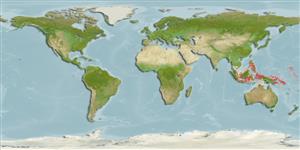>
Ophidiiformes (Cusk eels) >
Dinematichthyidae (Viviparous brotula)
Etymology: Alionematichthys: Name from Latin alius meaning the other or different, and nematichthys, the stem of the genus name Dinematichthys, to which this genus is most similar; plicatosurculus: Named for the characteristic folded inner pseudoclasper (Latin plicatus for folded and surculus for grapevine tendril used for the term pseudoclasper; noun in apposition.
More on authors: Møller & Schwarzhans.
Environment: milieu / climate zone / depth range / distribution range
Ecologia
marino associati a barriera corallina; distribuzione batimetrica 0 - 10 m (Ref. 81230). Tropical
Distribuzione
Stati | Aree FAO | Ecosystems | Presenze | Point map | Introduzioni | Faunafri
Western Pacific: Philippines, Indonesia, Papua New Guinea and the Solomon Is.
Size / Peso / Age
Maturity: Lm ? range ? - ? cm
Max length : 7.9 cm SL maschio/sesso non determinato; (Ref. 81230); 5.8 cm SL (female)
Short description
Chiavi di identificazione | Morfologia | Morfometria
Raggi dorsali molli (totale) : 76 - 84; Raggi anali molli: 60 - 67; Vertebre: 42 - 45. This species is distinguished by the following characters: D 76-84; A 60-67; moderately large eyes (2.2-3.0%SL); slender body; rounded snout, no cirri; scales only cheeks; upper preopercular pore absent; outer pseudoclasper broad-based, large, sometimes beyond the hood when in resting position, with thickened tip especially on the inner face, while the inner one is large, thick, with posterior lobe folded over anterior pointed lobe; otolith length to height 2.1-2.3, with gently curved dorsal rim; otolith length to sulcus length 1.6-1.7, ostium length to caudal length 3.5-4.5; vertebrae 11-12 + 31-33 = 42-45 (Ref. 81230).
Found on volcanic rock boulders and sandy channels, shallow coral reef (Ref. 81230). Cryptic, solitary inhabitant of shallow water (Ref. 90102).
Life cycle and mating behavior
Maturità | Riproduzione | Deposizione | Uova | Fecundity | Larve
Møller, P.R. and W. Schwarzhans, 2008. Review of the Dinematichthyini (Teleostei, Bythitidae) of the Indo-west Pacific, Part IV. Dinematichthys and two new genera with descriptions of nine new species. The Beagle 24:87-146. (Ref. 81230)
IUCN Red List Status (Ref. 130435: Version 2024-2)
Threat to humans
Harmless
Human uses
Pesca: di nessun interesse
Strumenti
Special reports
Download XML
Fonti Internet
Estimates based on models
Preferred temperature (Ref.
123201): 28.2 - 29.3, mean 28.9 °C (based on 786 cells).
Phylogenetic diversity index (Ref.
82804): PD
50 = 0.5005 [Uniqueness, from 0.5 = low to 2.0 = high].
Bayesian length-weight: a=0.00389 (0.00180 - 0.00842), b=3.12 (2.94 - 3.30), in cm total length, based on all LWR estimates for this body shape (Ref.
93245).
Trophic level (Ref.
69278): 3.3 ±0.5 se; based on size and trophs of closest relatives
Fishing Vulnerability (Ref.
59153): Low vulnerability (10 of 100).
